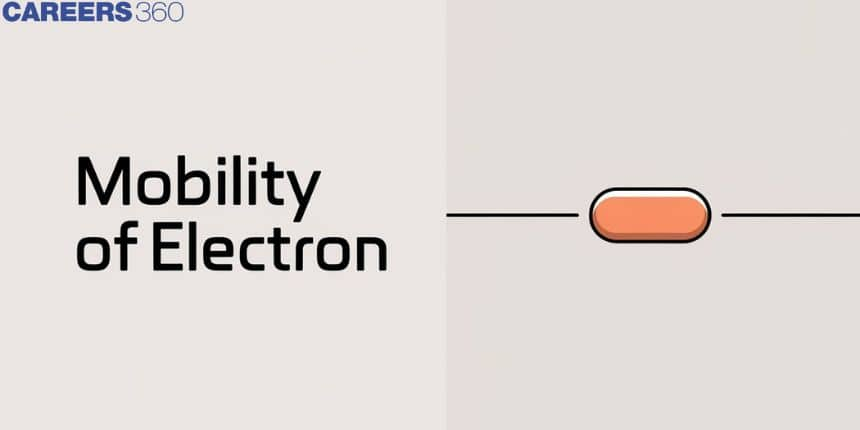Mobility Of Electron
Electron mobility refers to the ease with which electrons move through a material when subjected to an electric field. It is a key factor in determining the conductivity of materials, as higher mobility means electrons can travel more efficiently, leading to better current flow. Mobility depends on factors like temperature, impurities, and the material's structure. In real-life applications, electron mobility plays a vital role in devices like smartphones and computers, where semiconductors with high mobility are used to ensure fast processing speeds. It’s also essential in solar panels, where efficient electron movement leads to improved energy conversion. The concept of electron mobility helps engineers design better-performing materials in electronics, affecting everyday technology.
This Story also Contains
- What is Mobility?
- Solved Examples Based on Mobility Of Electron
- Summary

What is Mobility?
Drift velocity per unit Electric field is called the mobility of electrons.
$
\mu=\frac{v_d}{E}
$
$\mu-$ Mobility
$v_d-$ Drift velocity
Relation between Conductivity and Mobility
$
\sigma=\mu n e
$
Where n is the number of electrons per unit volume, e is the charge of the electron and is the conductivity.
In the case of a conductor, conductivity decreases with the increase in temperature and in the case of a semiconductor conductivity increases with the increase in temperature.
Recommended Topic Video
Solved Examples Based on Mobility Of Electron
Example 1: A current of 5 A passes through a copper conductor (Resistivity $=1.7 \times 10^{-8} \Omega \mathrm{m}$ ) of the radius of a cross-section of 5 mm. Find the mobility of the charges (in $\mathrm{m}^2 / \mathrm{Vs}$ ) if their drift velocity is:
$
1.1 \times 10^{-3} \mathrm{~m} / \mathrm{s}
$
1) 1
2) 1.5
3) 1.3
4) 1.8
Solution:
Mobility
$\begin{aligned} & V_d=\mu E=\mu\left(\frac{V}{l}\right)=1.1 \times 10^{-3} \mathrm{~m} / \mathrm{s} \\ & \rho=1.7 \times 10^{-8} \\ & I=5 A \\ & V_d=\mu\left(\frac{V}{l}\right)=\frac{\mu(I R)}{l}=\mu \frac{I}{l} \times \rho \frac{l}{A} \\ & V_d=\frac{\mu I \rho}{A} \\ & \mu=\frac{V_d A}{I \rho}=\frac{1.1 \times 10^{-3} \times 3.14 \times 25 \times 10^{-6}}{5 \times 1.7 \times 10^{-8}} \\ & \mu=1 \mathrm{~m}^2 / V \mathrm{~s}\end{aligned}$
Hence, the answer is the option (1).
Example 2: The dimension of mobility of electrons is
1) [M2T-2A]
2) [M-1T2A]
3) [M-2T3A]
4) [M-1T3A]
Solution:
$
\mu=\frac{v_d}{E}
$
wherein
$\mu-$ Mobility
$v_d-$ Drift velocity
Dimension of $\mathrm{v}_{\mathrm{d}}=\left[L \mathrm{~L}^{-1}\right]$
Dimension of $E=\left[\mathrm{MLA}^{-1} \mathrm{~T}^{-3}\right]$
Dimension of $\mu=\left[\mathrm{M}^{-1} \mathrm{AT}^2\right]$
Hence, the answer is the option (2).
Example 3: Which of the following factors does not affect mobility?
1) Temperature
2) Area of cross-section
3) Electric Field
4) All of the above
Solution:
Mobility
Drift velocity per unit Electric field is called the mobility of electrons.
$\mu = \frac{v_d}{E}=\frac{\sigma}{ne}=\frac{e \tau}{m}$
$\tau$ is a function of temperature.
$\mu=\frac{v_d }{E}$ is independent of the area of the cross-section.
Hence, the answer is the option (2).
Summary
Electron mobility refers to the ease with which electrons move through a conductor under the influence of an electric field. It is defined as the drift velocity per unit electric field. Factors like temperature and material properties affect electron mobility, where conductivity in conductors decreases with increasing temperature, but increases in semiconductors. Mobility can be calculated and its dimension is [M⁻¹T²A]. It is independent of the area of the conductor's cross-section.